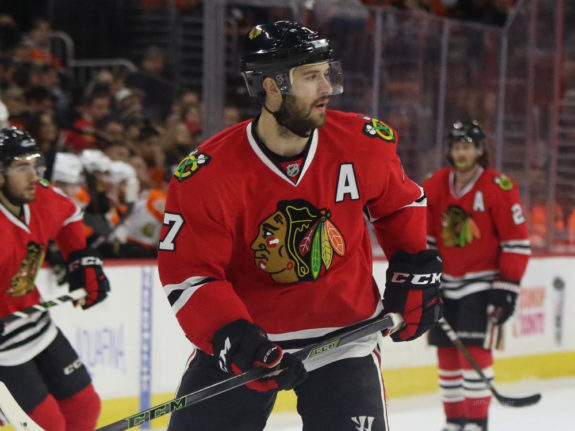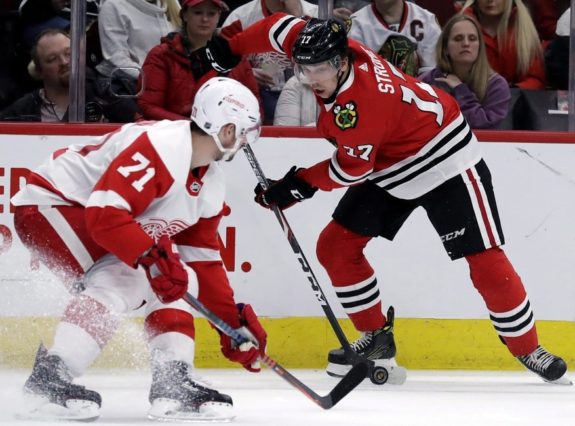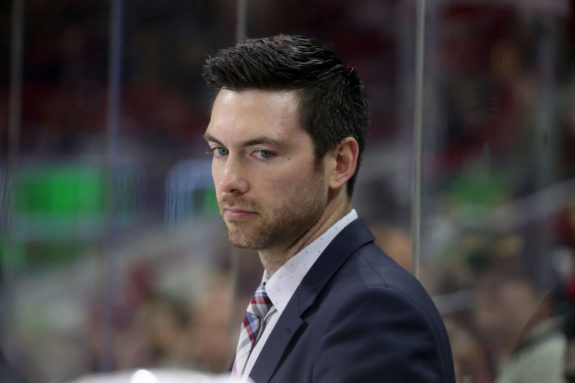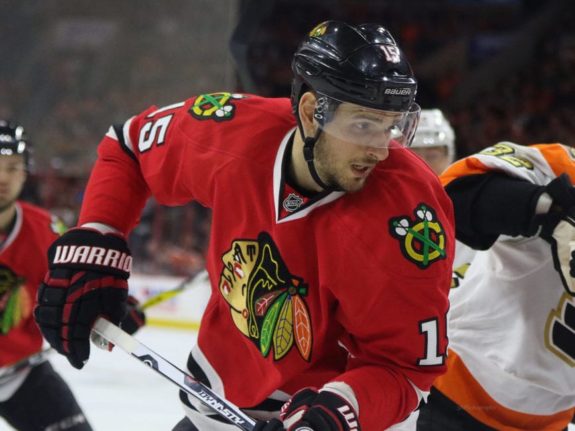Last week we looked at nine reasons for optimism for the Chicago Blackhawks in their upcoming 2019-20 campaign. I guarantee you’ll probably like that article better than this one. But the whole point here at The Hockey Writers is to analyze and dissect our favorite team. So today I play the devil’s advocate. While the Hawks appear to be trending in the right direction, there are still several obstacles and concerns. Without further ado, here are five reasons for pessimism as we look towards yet another season for the Blackhawks.
1. Keith & Seabrook Hampering Blue Line Progression
This is a tough thing to get around, and I’m not sure the organization could have done it any differently. Veteran defensemen Duncan Keith and Brent Seabrook were a HUGE part of three-Stanley Cup winning teams. They deserved to be rewarded accordingly. That’s how hockey works.
Keith is now 35 years old (he will be 36 in July), and is under contract for another four years with a $5.5 million cap hit and a no movement clause. Seabrook just turned 34, and is under contract for another five years with a $6.875 million cap hit and also a no movement clause.

Both players aren’t getting any younger. They’re making a lot of money, and they’re pretty much locked into staying Blackhawks for the rest of their careers. Which would be great if they were still performing at a level worthy of their contracts. But both are experiencing a natural and inevitable decline in their games.
Now don’t get me wrong. I’m a huge fan of both Keith and Seabrook and what they’ve done for the organization. I also still believe they have a lot to offer the team as long as they’re utilized correctly. But in order for the team to succeed, new blood should step into primary roles, and these two placed in more complementary roles.
But it’s pretty hard to compensate other players accordingly with the kind of money Keith and Seabrook are making. It’s a big reason the Hawks can’t procure another experienced top-four defenseman, and must instead rely on the youth in their system. Not to mention the logistics of balancing the ice time of other D-men against these two esteemed veterans. It’s a catch-22 with no easy answer. And it’s handicapping the team big time.
2. Lack of Center Depth
This is another situation that needs to be addressed if the Blackhawks want to get to the next level. Jonathan Toews is a high-end top center with a 56.3 percent faceoff percentage and a solid 200-foot game. But the Blackhawks don’t exactly have the ideal situation beyond that.
Dylan Strome has established himself as the current second-line center behind Toews. His offensive numbers support that, but his 44.9 percent in faceoff wins is nothing to write home about. His skating and defensive abilities also leave a bit to be desired.

Artem Anisimov was relied on much more before Strome came along. In his 11 years in the league, his faceoff percentage hovers right around 46 percent. Sure enough, this year he was at 45.7 percent. While Strome might still improve in this area, Arty will not.
The Russian center has shown chemistry with Patrick Kane in the past, and his net front presence and defensive responsibilities are certainly commendable. But without Kane on his line he tends to disappear. It should be noted Arty found a bit of a groove on a line with Brandon Saad towards the end of the season. But it might be too little, too late. He’s also making a hefty $4.55 million as a third-line center. It’s certainly not the ideal situation.
Anisimov has been rumored to be on the trading block for quite some time. Depending on the return, the Hawks could probably use the change. He simply doesn’t fit into the lineup anymore.
Finally, we get to the fourth-line center, which for most of last season was David Kampf. Kampf looks to succeed Marcus Kruger in this department. For the most part he’s been reliable in his role. But his 45.3 percent in faceoff wins could use some improvement (Kruger’s nine-year average is a little over 50 percent).
Kampf also doesn’t offer much offensive upside, but then again that’s not really his job. It’s only his second season in the NHL, so there’s still room for growth. If Kampf is going to be the shutdown center of the future, he needs to take another step in his game.
3. Colliton is Still Green
Head coach Jeremy Colliton will have a full preseason and regular season to work with in this upcoming campaign. Unlike last season, there will be no more excuses. I wrote in my optimism post we would see him develop and succeed even further. But we should keep in mind it could just as easily go the other way.

I questioned a number of Colliton’s decisions last season. For example, why did he consistently play 39-year-old Chris Kunitz over the young John Hayden? What was his reasoning behind sending his best overall defenseman, Henri Jokiharju, down to Rockford? Did he burn out Kane by relying on him too much? And WHY did he insist on having Keith and Seabrook on the points on the second power play unit?
But let’s say there is a method to the madness and Colliton does right the ship? Naturally, that means the Blackhawks will be playoff bound come April. Yet Colliton has never coached in an NHL postseason. Playoff hockey and navigating through a best-of-seven-game series is a whole different world.
The point here is the young coach has very little experience. Granted, the only way he can gain that experience is to experience it. And learn from it. But this takes time, and the Blackhawks’ championship window is closing as their core gets older. Colliton’s inexperience could prove a big disadvantage down the stretch.
4. Crawford Questions
Oh, the Corey Crawford conundrum. If he’s healthy, he’s leading the team to the promised land. He ended the 2018-19 season strong, posting a .933 save percentage and a 1.97 goals-against average in his last 13 games. But his previous concussion history is definitely a concern.
It’s a bit of a crapshoot to rely on Crow. It could be the best thing ever, or it could mean leaning on backup goaltenders that probably aren’t ready for the main role just yet.

But the Blackhawks have committed to Crawford, who has also committed to rehabbing from (at least) two major concussions. He’s shown he can still be an elite goaltender at the top of his game. As long as he can remain healthy.
As long as he can remain healthy. If not? Well that could be a huge problem. Fingers crossed.
5. The Penalty Kill
While the Blackhawks made some positive strides on the power play, their penalty kill ranked worst in the league this past season. Special teams play is extremely important, and the penalty kill must improve for the team to succeed.
So how will they go about doing this? That’s a good question. I mentioned above that Anisimov will likely be traded. Yet he was one of the Blackhawks’ best shorthanded players (from, Blackhawks player grades: Which forwards did enough this season’, The AthleticCHI – 4/18/19). Someone else will have to step into those skates.

Kruger might not be on the team next season either, but perhaps that’s not such a bad thing. He’s not the penalty killer he used to be. Seabrook spent more time on the PK than any other player on the team (from, ‘Blackhawks player grades: How did the defense stack up this season?’, The AthleticCHI – 4/17/19). It’s probably time for that to change.
Finding the right personnel and improving in this area is going to be a challenge for the Blackhawks. It will be something to keep an eye on as the season unfolds.
Some of the above reasons for pessimism can, and most likely will, be addressed in the offseason with the Hawks’ third-overall draft pick, trades, and free agency. Others will not. What do you think, Blackhawks fans? Can the Hawks overcome their obstacles and have a successful 2019-20 campaign? We’ll just have to wait and see.